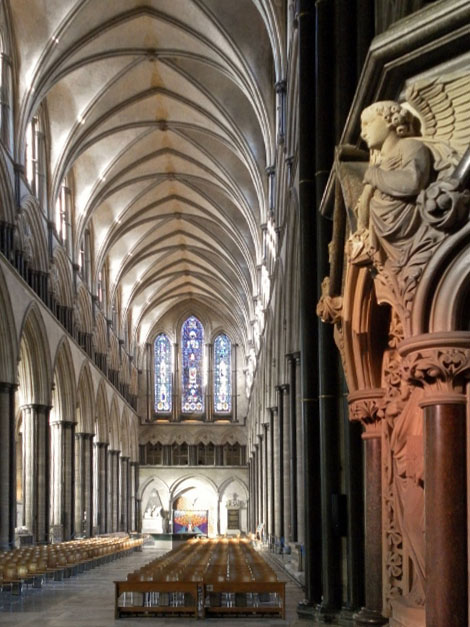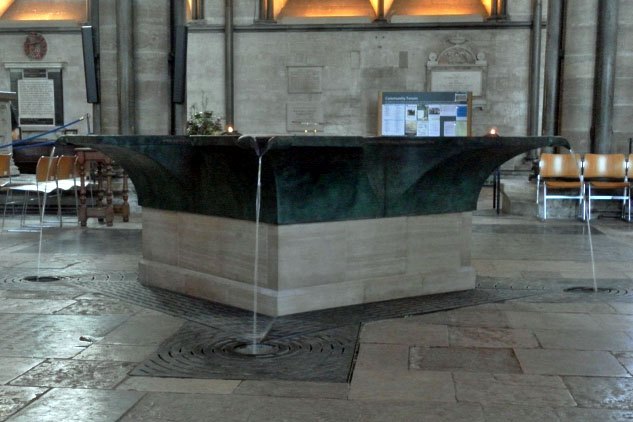| |
 |
 |
 |
| Comment on this report, or find other reports. |
 |
| Our Mystery Worshippers are volunteers who warm church pews for us around the world. If you'd like to become a Mystery Worshipper, start here. |
 |
| Find out how to reproduce this report in your church magazine or website. |
|
|
| 3254: Salisbury Cathedral, England |
 |
 |
 |
Mystery Worshipper: Beggarman.
The church: Cathedral Church of the Blessed Virgin Mary, Salisbury, England.
Denomination: Church of England, Diocese of Salisbury.
The building: Of chocolate-box improbability: if you saw a photograph of the cathedral on the lid of a box of choccies (or the local fudge), you would not believe it could possibly be like that in real life. But it is! Salisbury Cathedral was built in just 38 years (1220-58) – or rather 38 summers, because mortar froze in the winter. It survived the depredations of the 17th-century Civil War; the demolition in 1790 of its bell tower (thus making it one of only three English cathedrals that lack a ring of bells); and major renovation and repair. Superlatives abound: tallest spire in Britain still standing (404 feet); largest cathedral close in Britain (80 acres); oldest working clock in the world (made in 1386); home to the best preserved of the four copies of Magna Carta surviving from 1215. There are some magnificent modern additions to the furniture, notably the prominently positioned "Flowing Waters" font by the noted British water sculptor William Pye, dating from 2008. As if all that were not remarkable enough, the whole complex is a replacement of the original Old Sarum cathedral, which was dismantled stone by stone.
The church: Their website states that they are committed to social justice and social responsibility. Together with Rochester Prison, they conduct (quoting from their website) "programmes that demonstrate a commitment to helping people overcome barriers to employment." A portion of the cathedral's income is donated to charitable works. They are linked with dioceses in Sudan and South Sudan. Choral mattins, holy communion and choral evensong are celebrated regularly. The cathedral choir actively recruits boys and girls through its "Chorister for a Day" programme, where children and their parents can experience what it is like to be a cathedral chorister (and a chorister parent).
The neighbourhood: Salisbury lies about 90 miles southwest of London. Fortifications were built here as far back as the Iron Age. The Romans established a town they called Sorviodunum, which the Normans shortened to Sarum. William the Conqueror built a castle here in 1070, and a cathedral was completed in 1092. The site proved unsuitable, however, for a variety of reasons, and in 1220 an area some two miles to the south was chosen for a new cathedral. There a new town sprang up, and while New Sarum, or Salisbury, thrived, Old Sarum was eventually abandoned and fell to ruin, although it continued as a pocket borough or "rotten borough" to elect two members to Parliament until as late as 1832. Today Old Sarum is listed as a Grade I site administered by English Heritage. Stonehenge lies about eight miles to the northwest, a fact that (along with the cathedral) greatly benefits Salisbury's economy. The cathedral close itself is a gated community. All manner of people, local and visitors, flow through the close during the day. At night that great empty space falls quiet, as the gates are locked from 11.00pm to 6.30am. Beyond the walls are bustling city on one side; on the other, managed ("floated") water meadows, from where John Constable painted his famous study of the cathedral (1830-31).
The cast: Presiding: the precentor, the Revd Canon Tom Clammer.
Preaching: the vicar of the close, the Revd Canon Ian Woodward. Singing: Salisbury Cathedral Choir (the boys’ choir).
The date & time: Sunday, 5 November 2017, 10.30am.
What was the name of the service?
Choral Eucharist.
How full was the building?
A handsome, rather than a packed, congregation. There were a few spare seats in the quire; in the nave, all the best seats appeared to be taken.
Did anyone welcome you personally?
Very much so. There seemed to be a small army of volunteers who made it their personal mission to see that everyone arriving for the service had all they needed and could “just sit back and enjoy.”
Was your pew comfortable?
No pews: a choice between comfort (modern wood bucket-chairs in the nave) or fabulous sound but draughts in the quire stalls – unless you are a Small Person, in which case you can sit with your family in the reserved seats near the altar.
How would you describe the pre-service
atmosphere?
Buzzing with anticipation: people greeting and asking after fellow-regulars, as well as being attentive to newcomers.
What were the exact opening words of the
service?
"In the name of the Father, and of the Son, and of the Holy Spirit. Amen."
What books did the congregation use during the
service?
No books: all things necessary were contained in the booklet specially printed for that service on that day. This was just as well, because on the shelves in front of each seat in the quire was a bewildering array of books needed for other services: a white Order of Service; a burgundy Book of Common Prayer to follow the psalmody; a shiny black tome, with gold-tooled lettering, to follow the words of anthems sung by the choir; a leaf-green New English Hymnal and a faded orange-and-blue 100 Hymns for Today to sing any congregational hymns. As if that were not enough, there was also a bright amber-and-olive-green Holy Bible, New Revised Standard Version, in which to follow the readings.
What musical instruments were played?
The "Father" Henry Willis organ. It was built in 1877, with a new console added in 1934. It was overhauled in 1978 and again in 1993, but was never revoiced, enlarged or "improved" and sounds essentially the same today as it did back in 1877. Henry Willis himself considered it to be his finest opus.
Did anything distract you?
Liturgical ushers (they were probably vergers) gliding about the aisles as if on castor wheels, wearing emerald-green cassocks with black gowns and carrying ornate metal batons. From where I was sitting they looked like giant stag-beetles! But I'm sure they do a very necessary job in the time-keeping of the ceremonial so that everything flows smoothly.

Was the worship stiff-upper-lip, happy clappy, or
what?
Formal, but fun. This was truly "common worship": both the liturgy of that name and the full range from the beautifully choreographed choir and altar party to natural spontaneity of the younger members of the congregation, of whom there was a good number.
Exactly how long was the sermon?
11 minutes.
On a scale of 1-10, how good was the preacher?
8 – The Revd Canon Ian Woodward had a clear delivery and was not afraid to use long words alongside their non-technical equivalents.
In a nutshell, what was the sermon
about?
His text was the gospel for the day (Matthew 24:1–14 – Jesus describes the end times) and his subject was the apocalypse: the end times understood as painful change. He referred to an exhibition in the cathedral that had come to its last day: "Threads through Revelation" by textile artist Jacqui Parkinson.
Which part of the service was like being in
heaven?
All of it! From first walking into the cathedral and seeing that amazing cross between the Mirror of Galadriel from Lord of the Rings and Ezekiel’s vision of the Temple – that is to say, William Pye's Flowing Waters font – right through to the final procession. Among the highlights on the way: the music. Wow, that choir is in good voice at the moment! The fare for this service: Victoria's Missa O Quam Gloriosum; for the anthem, the motet Ave Verum Corpus by the 16th century English composer Peter Pillips; recessional by JS Bach (his Prelude in F minor, BWV 534). And I know the place must be mobility-disabled-friendly, because at least three of the crew (ministry team and regular congregation) were wheelchair users, including the person leading the service.
And which part was like being in... er... the other place?
If I had been one of those trying to engage in the evening eucharist for All Souls, and exiled behind the temporary platform erected in the middle of the nave days in advance (why?) for the graduation ceremony of Wiltshire College, I would have been really quite annoyed! Thankfully, by Sunday morning the platform and all other vestiges of the graduation ceremony had been taken down. But even so, the truly hellish bit was finding my way into the cathedral. I was confused by, but eventually dismissed, a sign that told me the place would be closed from 1.00pm on Friday (or was it Saturday?) for the said Wilts Coll grad-fest. But having passed that hurdle, I remained puzzled by whether one should go in by the porch on the north side, or the normal entrance on the south side and brave the keepers of the ticket-booth, who have a knack of making it sound like people coming in have to pay an entrance fee when actually it’s supposed to be a donation.
What happened when you hung around after the service looking lost?
I was instantly scooped up by members of the congregation eager to bear me off to have coffee at the west end, and be introduced to other members of the congregation.
How would you describe the after-service
coffee?
Real coffee with real milk. And someone circulated with a plate of that favourite British jam-and-shortbread snack, jammie dodgers (or were they jammie wagon wheels?) – yummy anyway.
How would you feel about making this church your regular (where 10 = ecstatic, 0 = terminal)?
9 – Dignified but lively and enlivening worship; world-class music; an engaged congregation; a full programme of alternative services during the week (e.g. later that day, a wonderfully creative "Stations of the Apocalypse" before they dismantled that particular art installation) – what’s not to like? Except I suspect I would feel embarrassed about worshipping in a place where some of the front-of-house staff don’t have the same gift for making visitors welcome, as the welcomers do for people arriving specifically for a service.
Did the service make you feel glad to be a
Christian?
Oh yes!

What one thing will you remember about all this in seven days' time?
The first sight of that fabulous font: it makes a parish-church holy-water stoop look like a mere finger bowl.
|
|
|
 |
 |
 |
| We rely on voluntary donations to stay online. If you're a regular visitor to Ship of Fools, please consider supporting us. |
 |
 |
 |
| The Mystery Pilgrim |
 |
| One of our most seasoned reporters makes the Camino pilgrimage to Santiago de Compostela in Spain. Read here. |
 |
 |
 |
| London churches |
 |
| Read reports from 70 London churches, visited by a small army of Mystery Worshippers on one single Sunday. Read here. |
| |
|
|
|
|


